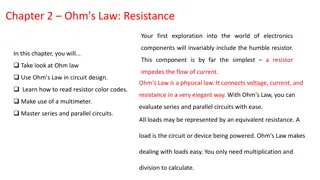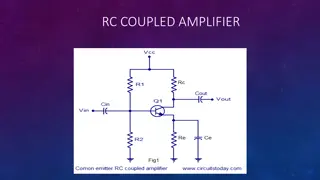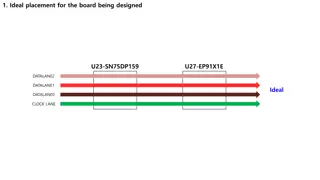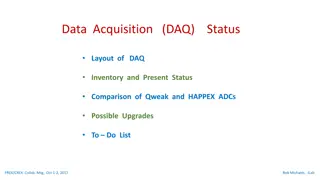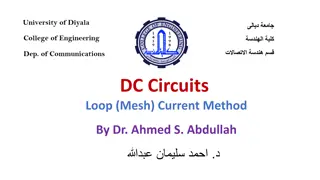RARA ELECTRONICS LLC
RARA Electronics LLC, a leading provider of resistive products since 1989, offers a wide range of high-quality resistors for various applications. With a strong global presence and a focus on innovation, RARA continues to grow and cater to the needs of customers worldwide.
0 views • 30 slides
High Stored Energy Emergency Discharge Systems Overview
This presentation discusses the high stored energy emergency discharge systems for klystron modulators used in RFQ/DTL and MBeta applications. It covers the storage locations of energy in various capacitor banks, the components of the system, and safety measures. The content includes detailed diagra
7 views • 10 slides
Understanding Ohm's Law and Electrical Resistance
Explore the principles of Ohm's Law and electrical resistance, understanding how resistance affects electron flow in circuits, the relationship between voltage drop and resistance, and practical examples of applying Ohm's Law in circuit calculations. Discover the impact of resistance in wires and ho
0 views • 19 slides
Understanding Electrical Quantities and Circuits in Physics
Explore the concepts of electrical quantities such as e.m.f., potential difference, resistance, current, and voltage in circuits. Learn about using voltmeters, measuring resistance, transferring energy in circuits, and understanding the relationships between these electrical properties. Delve into e
2 views • 65 slides
Understanding Electronic Components and Input/Output Devices
Explore the world of electronic components, input devices, and output devices through energy changes and symbol representations. Learn about LEDs, resistors, and energy conversions in a hands-on manner. Discover the role of various devices like microphones, solar cells, loudspeakers, and diodes in c
1 views • 24 slides
Understanding Wheatstone Bridge Circuit for Resistance Measurement
Wheatstone Bridge is a precise instrument for measuring unknown electrical resistances by balancing a bridge circuit. This practical application involves using resistors of known values to determine the unknown resistance. The voltage division formula plays a key role in calculating the unknown resi
0 views • 9 slides
Comprehensive Guide to Electric Circuits and Circuit Diagram Interpretation
Explore the fundamentals of electric circuits, circuit components, and diagram interpretation. Learn about series and parallel circuits, resistors, sources, switches, transducers, and more. Discover how to calculate resistance, current, and potential difference in circuits. Gain insights into diodes
2 views • 76 slides
Understanding Integrated Circuit Amplifiers and Design Philosophy
Integrated Circuit (IC) amplifiers are essential components in modern electronics, consisting of miniaturized active and passive devices on a semiconductor substrate. This article explores the building blocks, design philosophy, terminology, device variety, and biasing of ICs, emphasizing the use of
0 views • 11 slides
Understanding D'Arsonval Meter in Alternating Current Circuits
Explore the principles behind D'Arsonval meter in AC circuits, including half-wave rectification. Learn about sensitivity differences between DC and AC voltmeters, calculating series resistance, multiplier resistor values, and practical applications. Discover how shunt resistors improve linearity in
4 views • 13 slides
Understanding Electrical Principles in Industrial Electronics
Explore the fundamentals of industrial electronics, starting with direct current principles related to atomic theory, conductors, insulators, and resistors in series and parallel. Then, delve into alternating current principles, including generating an alternating voltage, alternating current (AC) b
0 views • 46 slides
Electric Current and Resistance: Lecture Highlights and Mid-term Exam Reminder
Today's lecture covers topics on electric current, resistance, Ohm's Law, resistors, resistivity, electric power, and microscopic views of current flow. Important announcements include reading assignments, mid-term exam details, online class rules, and exam guidelines. A refresher on electric curren
0 views • 19 slides
Electrical Circuit Analysis Examples and Solutions
Explore various examples of electrical circuit analysis involving batteries, resistors, and parallel connections. Learn how to calculate current, voltage, power dissipation, and equivalent resistance in different circuit configurations. Detailed solutions provided for better understanding.
0 views • 12 slides
Understanding Resistive Circuits in Electrical Circuit Theory Class
Explore the concepts of resistive circuits in ECEN 214 class with Prof. Adam Birchfield at Texas A&M University. Learn about series and parallel connections of resistors, solving examples, understanding Kirchoff's laws, and determining equivalent resistances. Enhance your knowledge of electrical cir
0 views • 23 slides
Light Tracking Servo System Using Cadmium Sulfide Resistors
Introduction to an Arduino-based light tracking system using Cadmium Sulfide light-dependent resistors. The system tracks the maximum light intensity and automatically adjusts its direction towards the brightest source. It includes an Arduino-based Lux Meter and specifications such as DAC resolution
0 views • 7 slides
Overview of Multivibrators: Types and Applications
Multivibrators are electronic circuits used for various applications such as oscillators, timers, and flip-flops. They consist of two amplifying devices cross-coupled by resistors or capacitors. The three main types are astable, monostable, and bistable multivibrators, each serving different purpose
0 views • 10 slides
Analysis of Low-Frequency Response in BJT and FET Amplifiers
This analysis delves into the low-frequency response of BJT and FET amplifiers, examining the impact of various components such as resistors and capacitors on the cutoff frequencies. Detailed examples illustrate the calculation process for determining these frequencies based on specific parameters.
0 views • 18 slides
Understanding Ohm’s Law and Resistors in Electronics
Explore the fundamentals of resistors in electronics, learn Ohm’s Law and its application in circuit design, decipher resistor color codes, understand resistor types and sizes, and master calculating unknown values in circuits. This chapter delves into the basics of resistance, voltage, current, r
0 views • 29 slides
Understanding RC Coupled Amplifiers and Transistor Basics
Amplification is the process of increasing signal strength without changing its characteristics. An RC coupled amplifier is a multistage amplifier using resistors and capacitors. Transistor amplifiers amplify signals based on transistors with different configurations. The common emitter configuratio
0 views • 23 slides
Understanding Noise in RF Integrated Circuits: Thermal and 1/f Noise
Noise, an unwanted input, limits a system's ability to process weak signals. Sources of noise include random noise in resistors and transistors, mixer noise, undesired cross-coupling noise, and power supply noise. Thermal noise, caused by thermal agitation of charge carriers, is also known as Johnso
1 views • 49 slides
Prototyping a Thermal Insulation Device with Microcontrollers and Sensors
In this lab project for Introduction to Engineering & Design, students work on prototyping a thermal insulation device using microcontrollers and sensors. The objective is to control an LED with a button, test a design prototype, and create a device to slow the rate of heat loss. Background informat
2 views • 23 slides
Understanding Parallel Circuits in Electronics
Explore topics such as resistors in parallel, voltage distribution, Kirchhoff's current law, resistance calculations, and practical applications in parallel circuits. Dive into problem-solving exercises and grasp concepts like current dividers, total resistance calculations, and power distribution i
0 views • 20 slides
Understanding Operational Amplifiers (Op-Amps) and Their Applications
Operational Amplifiers (Op-Amps) are devices used to amplify signals using an external power source. They are composed of transistors, resistors, and capacitors. Op-Amps find applications in summing amplifiers, AC and DC signal processing, digital-to-analog converters, active filters, oscillators, r
1 views • 41 slides
UITF MPS System Requirements and Protection Details
Combining hardware configuration and CEBAF-style FSD protection, the UITF MPS system ensures laser safety, vacuum control, and GUN HV stability. It protects against beam loss, maintains UHV, safeguards viewers, magnets, RF components, and more through a series of interlocks and comparator systems. T
0 views • 7 slides
Understanding Electric Circuits: Current, Voltage, and Resistance
Electric circuits involve the flow of electric current through conductors with varying levels of resistance. Current (I) is the amount of charge passing through a point in a wire per unit of time, measured in amperes. Voltage (V) is the potential difference required to make electrons flow in a condu
0 views • 25 slides
Electric Circuits: Series and Parallel Configurations Explained
In this lecture on electric circuits, we delve into series and parallel circuits featuring batteries, wires, resistors, and capacitors. Key concepts discussed include Kirchhoff's loop rule, series components, and equivalent resistance and capacitance. Learn how to simplify complex circuits and analy
0 views • 24 slides
Comprehensive Review of BJT CE Voltage Amplifier in Electronics Lab
This lecture provides a comprehensive review of the BJT CE voltage amplifier circuit, starting with theoretical concepts and moving towards practical implementations. It covers the operation of the BJT as a switch, the addition of resistors for current control, DC design considerations, AC voltage g
0 views • 19 slides
Designing STEM High School Physics: Engineering Irrigation Systems for Hydroponic Enthusiasts
Explore a hands-on workshop in high school physics focusing on simple circuits, series, and parallel circuits, with a practical application in designing irrigation systems for hydroponic enthusiasts. Dive into concepts like water pumps, variable resistors, and circuit design challenges. Enhance unde
0 views • 22 slides
Electrochemical Sensing Module Overview and Potentiostat Parameters
In this meeting, the Electrochemical Sensing Module based on the EmStat-pico potentiostat was discussed. The module features precise, low-power control unit Arduino MKR Zero and supports techniques such as voltammetry and EIS. Potentiostat parameters include a full dc-potential range, EIS frequency
0 views • 16 slides
Ideal Placement for Board Design with U23-SN75DP159 and U27-EP91X1E
The current status of the board under design includes various components such as resistors, capacitors, and integrated circuits (ICs) like PLL_XFC-2. Connections for TMDS_D2P, TMDS_D2N, TMDS_D1P, TMDS_D1N, TMDS_D0P, TMDS_D0N, and TMDS_CLKP are detailed. Additionally, there are references to HDMI int
0 views • 7 slides
Understanding Second-Order RLC Circuits in Electronics
Explore second-order RLC circuits in electronics, characterized by second-order differential equations and involving resistors, inductors, capacitors, and voltage sources. Learn about initial and final values of voltage and current, applications in filters, and the differential equations governing t
0 views • 13 slides
Understanding Bit Masking and Bitwise Operations for Efficient Bit Manipulation
Bit masking is a powerful technique in programming to selectively access or modify specific bits without affecting others. By creating a byte with bits set at desired positions using a bit mask, bitwise operators like OR (|) and AND (&) can be leveraged to efficiently set or clear specific bits. Thi
0 views • 11 slides
Comparison of Qweak and HAPPEX ADCs for Data Acquisition Status
Layout and present status comparison of Qweak and HAPPEX ADCs for Data Acquisition status. Includes inventory details, possible upgrades, and discussions on integrating signals over the helicity period. Highlights differences in design and specifications between the two ADC systems, along with recen
0 views • 15 slides
Understanding DC Circuits: Mesh Current Method by Dr. Ahmed S. Abdullah
The DC Circuits Loop (Mesh) Current Method, explained by Dr. Ahmed S. Abdullah, applies Kirchhoff's Voltage Law (KVL) to find unknown currents in a circuit. This method involves assigning loop currents to loops, applying KVL to each loop, and indicating voltage polarities across all resistors based
0 views • 31 slides
Understanding Energy Losses in Pipe Flow and Complex Network Connections
Energy losses in pipe flow are primarily due to boundary friction, with additional losses such as sudden enlargements and contractions. Complex network pipe connections involve series and parallel arrangements, analogous to current flow through resistors. Open channel flow is also a critical aspect
0 views • 4 slides
Physics Lecture Summary: AC, EMF, and Special Project Reminder
In today's physics lecture, Dr. Jae Jaehoon Yu discussed alternating current (AC) and EMF, emphasizing the microscopic view of electric current and Ohm's Law. The lecture included details on resistors in series and parallel circuits. An upcoming quiz on Chapter 25 was announced, along with a mid-ter
0 views • 24 slides
Understanding I2C Bus Interface and Protocol
I2C, short for Inter-Integrated Circuit, is a serial protocol with a two-wire interface designed by Philips. It allows communication between master and slave devices using start and stop conditions. Each slave device has a unique address, and data transfer occurs in serial 8-bit packets at varying s
0 views • 11 slides
Evolution of Amplifiers: From WWII to Modern Integrated Circuits
Amplifiers have come a long way since their invention during WWII for mathematical operations. The modern amplifier is compact, high-performing, and integrated with transistors, resistors, and capacitors on a single chip. The properties of operation amplifiers, input modes, and differential inputs a
0 views • 10 slides
Exploring Electronic Alarm Circuits and Devices
Discover the workings of various electronic alarm circuits such as Frost Alarm, Fire Alarm, and Burglar Alarm. Learn how different sensors and components like thermistors, resistors, transistors, and capacitors are utilized to trigger alarms based on temperature changes, light conditions, and time d
0 views • 23 slides
Precision Linear Analog Circuit Analysis
Explore the detailed analysis of a precision linear analog circuit, featuring dual feedback configurations, beta values, control loop derivations, and loop gain calculations. The content covers key components, such as operational amplifiers and resistors, and explains how to derive closed-loop gain,
0 views • 18 slides
Understanding Strain Gauges and Deformation in Beams
Explore the concepts of strain gauges and resistors, how loading deforms beams, and Da Vinci's insights on spring bending. Learn about axial strain measurement, strain proportional to resistance change, bridge circuits, and formulas for cantilever beams. Understand the importance of strain gauge att
0 views • 9 slides















